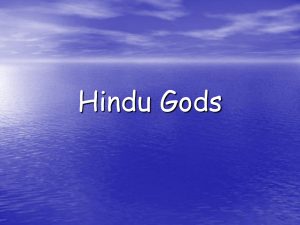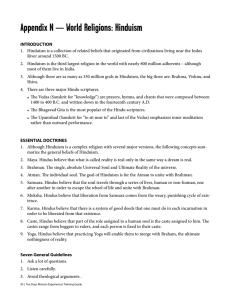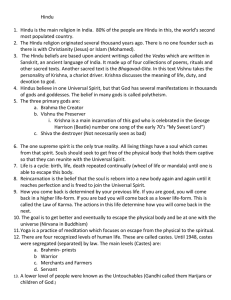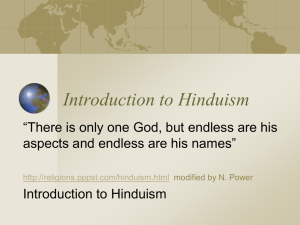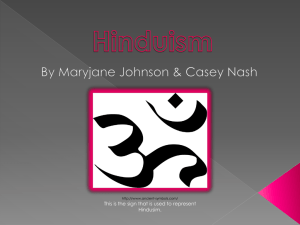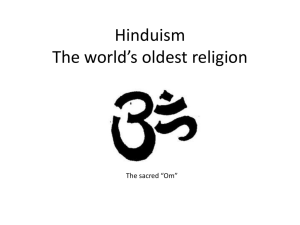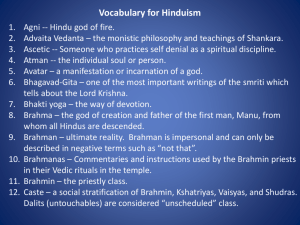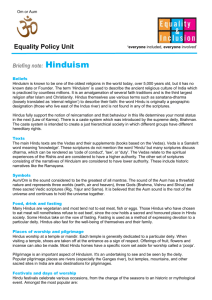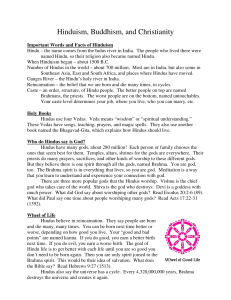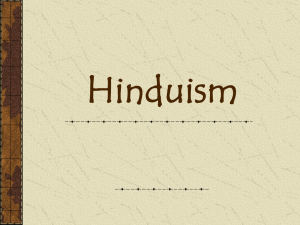Hinduism in Ancient India
advertisement
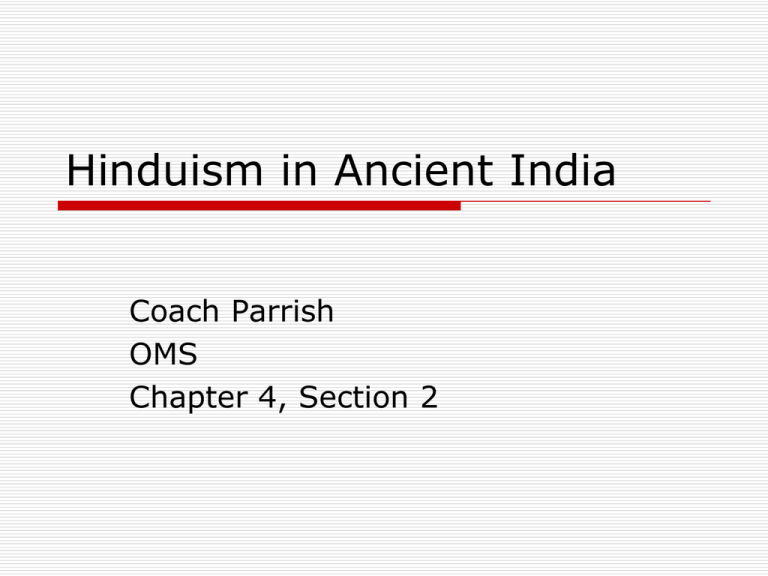
Hinduism in Ancient India Coach Parrish OMS Chapter 4, Section 2 New Delhi Temple – Largest Hindu Temple in the World Beginnings of Hinduism Aryan prayers and hymns were passed down through generations, mixing with India’s existing cultures. The ideas and beliefs were added to the Vedas. This blending of ideas and beliefs brought about one of the oldest world religions, Hinduism. Blend of Religions As Hinduism developed, it absorbed many different practices. Hindus believe that since people are different, they need different ways of worshipping. There are approximately 850 million practicing Hindus in India today. Hindus believe in many gods and goddesses, but believe in one single spiritual power called brahman which lives in everything. Hindu Gods and Goddesses The gods and goddesses of Hinduism stand for different parts of brahman. Important Hindu gods are Brahma – the Creator; Vishnu – the Preserver; and Shiva – the Destroyer. Avatar – representation of a Hindu god or goddess in human or animal form. Hindu teachings say that Brahma was born from a golden egg, and then created everything. Mt. Kailash – Sacred Home of Shiva in Tibet Hindu Gods and Goddesses, cont. Hindus believe that Vishnu is a kindly god who is concerned with the welfare of human beings. Vishnu visits Earth occasionally in different forms. He does this to guide humans or to protect them from disaster. Unlike Vishnu, Shiva is not concerned with human matters. He is very powerful and responsible for both the creative and destructive forces of the universe. Hindu gods have their own families. Many Hindus worship Shiva’s wife, the goddess Shakti. The Upanishads Upanishad – one of Hinduism’s religious texts that means “sitting near a teacher.” Much of the text is in the form of questions by students and responses by teachers. Reincarnation Reincarnation – rebirth of the soul. It is one of the main ideas in the Upanishads. Hindus believe that when a person dies, the soul is reborn in the body of another living thing. According to the Hindus, a person’s life affects his or her fate in the next life. Good behavior is always rewarded in the next life. Bad behavior is always punished. If a person lives a good life, they may be elevated to a higher position in the next life. If a person lives a bad life, they may be sent to a lower caste or even be reborn as an animal. If a person lives a perfect life, he or she may be freed from the cycle and their soul becomes one with brahma. A Hindu’s Duties To become united with the one spirit and escape the death and rebirth cycle, a person must obey his or her dharma. Dharma – religious and moral duties of each person. The duties depend on a person’s class, age, and occupation. Ahimsa – nonviolence. Ahimsa is another important Hindu practice that states that all living creatures are part of brahman and therefore should not be harmed. Many Hindus will therefore not eat meat or harm living creatures. The Yogas Hindus believe that yoga exercises help free the soul from the cares of the world. In this way, the soul can unite with Brahma. The word yoga means “union.” For Hindus, there are many yogas that can be used as paths to brahman. 1. Physical activity (yoga) 2. Yoga of selfless deeds (giving to poor) 3. Yoga of knowledge (learning sacred texts) 4. Yoga of devotion (honoring a personal god) Shiva in Yoga Meditation Private Devotion Hindus worship in public by praying and performing rituals in temples. They also show devotion at home. It is common for Hindus to choose a personal god, and honor that god by offering food, gifts, and prayers at a home altar. A Hindu’s devotion to the god brings the soul closer to brahman.

